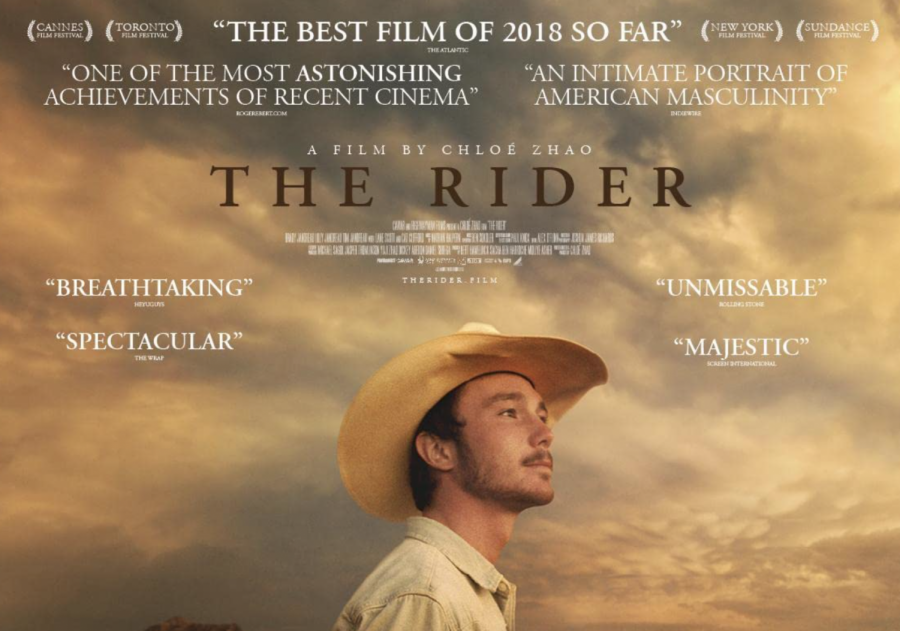Hidden Gem: “The Rider” (2017)
“The Rider” movie poster starring Brady Jandreau.
March 16, 2021
Several weeks ago, Chinese writer and director Chloé Zhao became the second woman to win a Golden Globe Award for best director for her independent drama “Nomadland,” which stars Frances McDormand. Within the week she may very likely become only the sixth female to be nominated for an Academy Award as best director.
Few people seem to know of her work, yet she has made several other films, including this week’s overlooked gem “The Rider” (2017). This semi-docudrama is based on fact and concerns a young cowboy who undertakes a journey of self-discovery after suffering a concussion and near-fatal head injuries in a rodeo competition.
Set in South Dakota, Brady Blackburn (Brady Jandreau) is a rodeo cowboy and horse trainer who learned his skills from his parents and family. He’s a high school dropout who never received a GED. He’s raised by his father since his mother died years before. With no other obvious skills or career options, after his injury he’s experiencing the deep depression and disappointment of possibly not being able to do the only thing he knows how to do well. The film becomes a character study or sort of “slice of life” tale without too much plot or excessive narrative complexity.
In the film’s opening scene, Brady wakes early in the morning to take pain pills, and we notice a significant scar with stitches that runs five or six inches above his right ear and back of his head. He experiences a flashback to a rodeo bronco ride, and later when talking to a friend about his slow recovery, he’s told a “real cowboy rides through the pain.” The friend also reminds him, “You get scared… Some guys just become farmers.” This is clearly not an option Brady wants to consider.
While this film has no significant female characters, except for Brady’s 15-year-old sister Lilly, Zhao’s personal touch appears to be the way of presenting Brady as a sensitive and caring young man.
Get The Daily Illini in your inbox!
In several key scenes, Brady shows genuine compassion for a paralyzed close friend and fellow rodeo cowboy named Lane Scott. He spends time with him in a rehab center where they watch videos of their rodeo rides and chat about their great times riding. Although Scott can barely communicate from his injuries, Brady patiently tries to understand his buddy.
In a couple of special scenes, Brady begins the process of taming two unruly horses whose owners say they aren’t letting anyone ride them. One beautiful black Arabian male whines and bucks wildly until Brady wins him over. Zhao spends extended time carefully showing Brady’s sincere love for the troubled animals as he slowly talks to them and gains their trust.
Later when Brady’s horse Apollo severely injuries its hind leg and his father must shoot the poor horse, Brady sadly admits to his sister, “I got hurt like Apollo did…and I got to live.”
After working part-time at a local food mart, training a few local horses and nearly pawning his expensive saddle, Brady can’t deny his true calling. Despite doctors’ warnings about his arm and hand seizures and the risks of further head injuries, Brady decides to rejoin the rodeo riding circuit.
The film’s acting is simply outstanding and completely natural. In addition to Lakota Sioux actor Brady Jandreau who stars as Brady, his own real-life sister, Lilly, and father, Tim, play Lilly and Wayne Blackburn, his character’s sister and dad respectively.
Still another outstanding quality of the film is its beautiful look and visual style. Cameraman Joshua James Richards makes effective, artistic use of numerous nearly still natural images and panoramic views of open fields, dotted with wire fences at sunrise, a lone windmill turning in the breeze or a richly lighted night scene around a campfire. Richards utilizes natural low-key light sources to accent Brady’s various depressed moods and emotions. Several of the movie’s long sequences have the same pensive feel of those closing nature scenes from the CBS Sunday Morning Program.
One thing is for sure: Chloé Zhao is one filmmaker people will be taking notice of in the near future.







